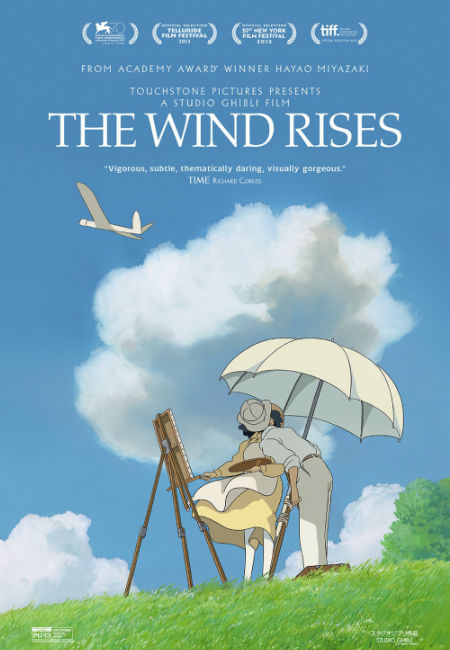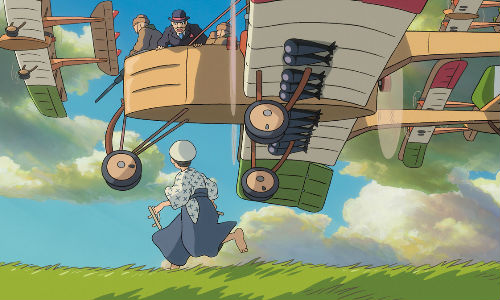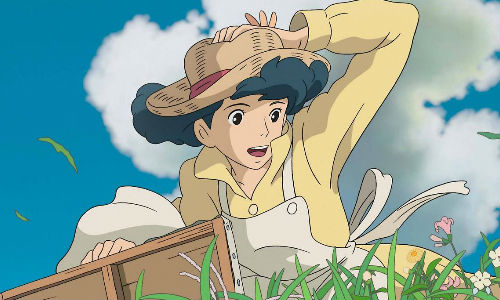
“Le vent se lève! … il faut tenter de vivre!” (“The wind is rising! We must try to live!”)
The Wind Rises is as close as a movie can come to being a masterpiece.
The reputedly final feature film from master animator Hayao Miyazaki (Castle in the Sky, Spirited Away, Howl’s Moving Castle), although it appears he has since backtracked from his previous declaration that he would retire from his work at the famed Studio Ghibli, The Wind Rises is a commanding artistic statement that not looks beautiful, it has the soul of a poet and the fanciful imagination of a creative dreamer.
Which is exactly what the often studiously serious Jiro Horikoshi (Hideaki Anno/Joseph Gordon-Levitt), a young man fixated with the romance and technicalities of flight, and whose dreams are filled with images of plane majestically aloft across magical landscapes, is down to the very fibre of his being.
From a young age, the man who would go on to design Japan’s fearsome Zero fighter plane, imagined himself meeting with Count Giovanni Battista Caproni (Mansai Nomura/Stanely Tucci), an aeronautical engineer and aviation pioneer, whose exploits Horikoshi followed via English language magazines given to him by a teacher at his school.
Caproni was in many ways a mentor to the young Horikoshi, though there is no record the two men ever met in person, so Miyazaki has them meeting at length in the budding Japanese aircraft designer’s dreams, where almost anything is possible.
These dream sequences, which are the most fantastical element in a movie that otherwise resolutely sticks to the real world of early to mid twentieth century Japan, an era in which Japan undergoes tremendous technological and societal change, are vividly realised.

Awash in the vibrant colours we have come to expect from any Miyazaki creation, they drip with fancifulness and whimsy, but also function as a manifestation of Horikoshi’s great love affair with planes and the magic of flight.
While much has been made of the role that Mitsubishi’s chief aeroplane designer played in equipping Japan’s militaristic march across Asia in World War Two, The Wind Rises in no way celebrates this period in the country’s history (mirroring Miyazaki clearly stated pacifist views), its gaze turned firmly to Horikoshi’s love of planes alone.
So enamoured with the limitless possibilities of aviation is he that he appears oblivious to the evil of Hitler’s regime when he sent there in the 1930s to check out the work of German aircraft designer Hugo Junkers, the only hint that he is aware of what might be wrought by his creations is a discussion with a German tourist to Japan Castorp (Steve Alpert/Werner Herzog) who warns Hirokoshi of the great destruction triggered by the increasingly nationalist posturing of Germany and Japan.
While it acknowledges the role of Horikoshi’s innovative designs, which propelled Japan’s aviation industry from industrial backwater to cutting edge in the space of a generation, in the perpetration of Japan’s war effort, the emphasis is clearly on the young designer romantic love of flight, and his devotion to the love of his life, Naoko Satomi (Miori Takamoto/Emily Blunt), who he first meets when he saves her from the destruction of the Great Kanto Earthquake of 1923.

This momentous natural disaster, which reduced much of Tokyo to smoking ruin, is depicted in graphic form, its waves of tectonic energy and the firestorm it unleashes, garishly coloured and palpably alive with murderous intent.
It is a symbolic precursor to the ruin later visited by Japanese defeat at the end of World War Two, when much of the country lay in ruins, a fulfilment of predictions made by both Caproni and Castorp that no matter how pure the intent of the creator, no one can control the vices and moral failings of the eventual users.
Castorp makes a point of reminding Horikoshi of this, but he clearly chooses to focus only on the act, the rush of creation and not its resulting consequences.
The genius of The Wind Rises is that it makes these points in a way that is not heavy handed, and that acknowledges first and foremost that Horikoshi is an artist of the air, a man so in love with aeroplanes that he ignores what they can be made to do by less idealistic minds.
It is a failing perhaps, but Miyazaki does not condemn Horikoshi for it, choosing to accent a theme common to many of his other movies, namely that there are two sides to every coin, and that something beautiful, enchanting and magical can also be deadly and destructive.
As always he weaves this potent message into a movie that is poignant, heartfelt and awash with equal mixes of sadness, joy and agony, its landscapes lavishly rendered in all the colours of the rainbow, with astonishing attention to historical detail.
The Wind Rises is an enchanting, gorgeously drawn and emotionally resonant effort that, regardless of whether it is Miyazaki’s final film or not, is testament to the limitless breadth and beauty of his vision, an artistic statement without peer that reminds us that life is never given over to stark black and whites, and that any act of creation, however pure is its genesis, also carries with it the seeds of destruction.